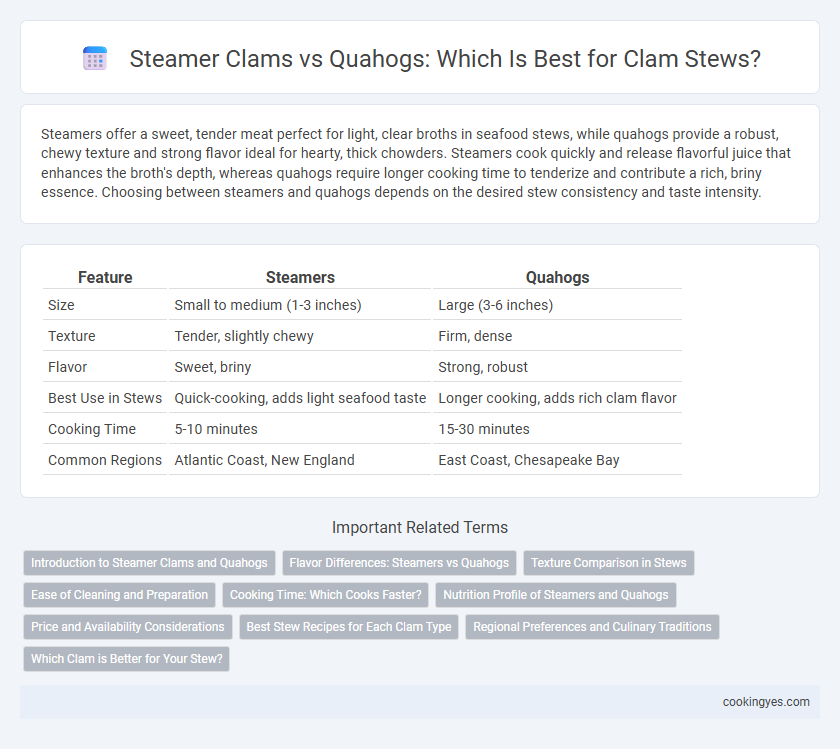Steamers offer a sweet, tender meat perfect for light, clear broths in seafood stews, while quahogs provide a robust, chewy texture and strong flavor ideal for hearty, thick chowders. Steamers cook quickly and release flavorful juice that enhances the broth's depth, whereas quahogs require longer cooking time to tenderize and contribute a rich, briny essence. Choosing between steamers and quahogs depends on the desired stew consistency and taste intensity.
Table of Comparison
| Feature | Steamers | Quahogs |
|---|---|---|
| Size | Small to medium (1-3 inches) | Large (3-6 inches) |
| Texture | Tender, slightly chewy | Firm, dense |
| Flavor | Sweet, briny | Strong, robust |
| Best Use in Stews | Quick-cooking, adds light seafood taste | Longer cooking, adds rich clam flavor |
| Cooking Time | 5-10 minutes | 15-30 minutes |
| Common Regions | Atlantic Coast, New England | East Coast, Chesapeake Bay |
Introduction to Steamer Clams and Quahogs
Steamer clams, also known as soft-shell clams, have thinner shells and a more delicate, tender texture ideal for steaming and quick cooking methods in stews. Quahogs, or hard clams, possess thicker shells and a denser, chewier meat that requires longer cooking times, lending a robust flavor to clam chowders and hearty stews. Understanding these differences allows chefs to select the appropriate clam type, enhancing the dish's overall texture and taste profile.
Flavor Differences: Steamers vs Quahogs
Steamers offer a sweet, briny flavor with tender, chewy meat that enhances the delicate taste of seafood stews. Quahogs, also known as hard clams, provide a stronger, more robust flavor with a firmer texture, delivering a rich and hearty depth to chowders and clam-based dishes. The distinct taste profiles of steamers and quahogs influence the overall flavor complexity and mouthfeel of clam stews, making ingredient choice crucial for desired culinary results.
Texture Comparison in Stews
Steamers offer a tender, slightly chewy texture that absorbs stew flavors while maintaining a delicate bite, ideal for a balanced mouthfeel. Quahogs, especially the large chowder variety, provide a firmer, meatier texture that adds substantial chewiness and robustness to stews, enhancing hearty recipes. The choice between steamers and quahogs for stews depends on desired texture contrast--steamers soften the stew's profile, whereas quahogs introduce a pronounced, dense chew.
Ease of Cleaning and Preparation
Steamers are easier to clean and prepare for stews due to their thinner shells and naturally less sand retention, which reduces the need for extensive scrubbing and rinsing. Quahogs have thicker, tougher shells and often contain more sand, requiring longer soaking and more thorough cleaning to ensure grit-free stews. Choosing steamers minimizes prep time and simplifies the cleaning process while maintaining rich, briny flavor in clam stews.
Cooking Time: Which Cooks Faster?
Steamers generally cook faster than quahogs, taking about 5 to 7 minutes to open when steamed, while quahogs often require 10 to 15 minutes due to their thicker shells and denser meat. The shorter cooking time of steamers makes them ideal for quick stews, preserving their tender texture and sweet flavor. Quahogs, with a longer cooking time, offer a firmer chew and more robust taste, suitable for recipes needing prolonged simmering.
Nutrition Profile of Steamers and Quahogs
Steamers and quahogs both provide essential nutrients but differ in their nutritional profiles relevant to stews. Steamers are lower in calories and fat, offering a lean source of protein with high levels of vitamin B12, iron, and omega-3 fatty acids, which support heart and brain health. Quahogs contain higher amounts of zinc and selenium, important for immune function and antioxidant defense, adding robust mineral content to hearty stew recipes.
Price and Availability Considerations
Steamers are generally more affordable and widely available in coastal markets, making them a cost-effective choice for clam stews. Quahogs tend to be pricier due to their larger size and slower harvesting process, often found in specialty seafood stores or during peak seasons. Price fluctuations for both types depend on regional supply, with steamers favored for budget-conscious recipes and quahogs prized for richer, meatier textures despite higher costs.
Best Stew Recipes for Each Clam Type
Steamers offer a sweet, tender texture that enhances brothy chowders and light garlic butter stews, making them ideal for recipes emphasizing delicate seafood flavors. Quahogs, also known as hard clams, have a robust, chewy bite perfect for hearty, spicy tomato-based stews or classic New England clam chowder, providing a rich depth of flavor. For optimal stew results, use steamers in dishes that highlight freshness and subtlety, while quahogs shine in bold, slow-simmered preparations that extract their intense clam essence.
Regional Preferences and Culinary Traditions
Steamers and quahogs each hold distinct places in regional clam stew recipes across the Northeastern United States. Steamers, prized for their tender, sweet meat, are favored in New England coastal communities, often prepared simply to highlight their natural flavor. Quahogs, or hard clams, are popular in Mid-Atlantic and southern New England, where their robust, chewy texture and stronger briny taste enhance rich, tomato-based chowders and hearty stews.
Which Clam is Better for Your Stew?
Steamers, also known as soft-shell clams, offer a tender texture and slightly sweet flavor that enhances the broth's richness in clam stews. Quahogs, or hard-shell clams, provide a firmer bite with a brinier taste that holds up well in hearty, robust stew recipes. Selecting between steamers and quahogs depends on whether you prefer a delicate, melt-in-your-mouth experience or a chewy, savory clam presence in your stew.
Steamers vs Quahogs for stews Infographic

 cookingyes.com
cookingyes.com